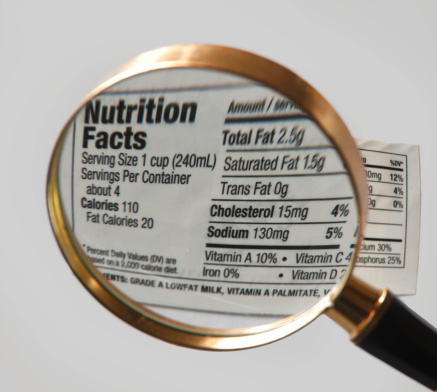41 e on food labels
Food labels - Better Health Channel Under labelling laws introduced in Australia in 2003, virtually all manufactured foods must carry an NIP. There are exceptions to the labelling requirements, such as: very small packages and foods like herbs, spices, salt, tea and coffee single ingredient foods (such as fresh fruit and vegetables, water and vinegar) food sold at fundraising events PDF Food Labeling Guide Office of Nutrition, Labeling, and Dietary Supplements HFS-800 Center for Food Safety and Applied Nutrition Food and Drug Administration 5100 Paint Branch Parkway College Park, MD 20740 (Tel)...
Food labels - NHS Some front-of-pack nutrition labels use red, amber and green colour coding. Colour-coded nutritional information tells you at a glance if the food has high, medium or low amounts of fat, saturated fat, sugars and salt: red means high amber means medium green means low In short, the more green on the label, the healthier the choice.

E on food labels
What's that little 'e' symbol? | Dieline - Design, Branding & Packaging ... The tolerable negative error is related to the nominal quantity and varies between 9% on prepackages nominally 50 g or mL or less, to 1.5% on packages nominally 1 kg or L or more. The estimated sign looks like a lower-case "e" and its shape is precisely defined by an EU directive. Smithfield Packaged Meats Corp. Recalls A Ready-To-Eat Bacon Topping ... Please view the additional products within "view labels" below. Consumers should check back frequently as additional products could be added. ... Consumers with food safety questions can call the toll-free USDA Meat and Poultry Hotline at 888-MPHotline (888-674-6854) or live chat Ask USDA from 10 a.m. to 6 p.m. (Eastern Time) Monday through ... How To Read Food and Beverage Labels | National Institute on Aging Sign up for e-alerts about healthy aging For more information about food labels USDA MyPlate 703-305-2060 U.S. Department of Health and Human Services 877-696-6775 U.S. Food and Drug Administration 888-463-6332 druginfo@fda.hhs.gov
E on food labels. eCFR :: 21 CFR Part 101 -- Food Labeling § 101.1 Principal display panel of package form food. The term principal display panel as it applies to food in package form and as used in this part, means the part of a label that is most likely to be displayed, presented, shown, or examined under customary conditions of display for retail sale. The principal display panel shall be large enough to accommodate all the mandatory label ... Food Labels | Nutrition.gov Food Labels Food labels can help you make healthy choices when buying food in grocery stores or restaurants. Labeling Organic Products USDA, Agricultural Marketing Service, National Organic Program Learn about organic foods, requirements, and how they are labeled. Calories on the Menu HHS, Food and Drug Administration USDA ERS - Food Labeling Manufacturers with $10 million or more in annual sales were required to switch to the new label by January 1, 2020; manufacturers with less than $10 million in annual food sales had until January 1, 2021 to comply. Future research can investigate whether the changes improved the diet quality of U.S. consumers. Food-Info.net : What does the e-sign mean on a label The e -sign on a food label indicates that the volume or weight of the product is an average value. Packaging machines in the food industry are not completely accurate; there will always be a margin of inaccuracy.
Food Labeling & Nutrition | FDA Food labeling is required for most prepared foods, such as breads, cereals, canned and frozen foods, snacks, desserts, drinks, etc. Nutrition labeling for raw produce (fruits and vegetables) and... E numbers (food additives) | DermNet NZ E124. Ponceau 4R. A synthetic coal tar dye, red in colour. Often used to restore red colour to tinned strawberries. Also added to strawberry jam, jelly and ice cream, tomato soup, savoury rice, cheesecake mix and some meat products. E127. Erythrosine. A synthetic coal tar dye, red in colour, rich in mineral iodine. The Basics of the Nutrition Facts Label Step 4: Check Out the Nutrition Terms. Low calorie: 40 calories or less per serving. Low cholesterol: 20 milligrams or less and 2 grams or less of saturated fat per serving. Reduced: At least 25% less of the specified nutrient or calories than the usual product. Good source of: Provides at least 10 to 19% of the Daily Value of a particular ... Food Labels | CDC If you eat the whole thing, you are eating 8 times the amount of calories, carbs, fat, etc., shown on the label. Total Carbohydrate shows you types of carbs in the food, including sugar and fiber. Choose foods with more fiber, vitamins, and minerals. Choose foods with lower calories, saturated fat, sodium, and added sugars. Avoid trans fat.
E-labels on foods - newtech.law The EU's Food Information to Consumers Regulation (1169/2011), which has been in force for nearly two years, was designed to simplify the rules on labelling of foods so that food labels would be clear, legible and understandable for consumers. e-symbol on labels - What it is and Why. - GLOW SKINCARE The e -sign on the label indicates the legally accepted average and margins for the product. The EU allows a slight variance, or margin of error. This means that occasionally you might get slightly more, or less than the label says. But, on average consumers will get what's advertised on the label. This is why it's called the 'average fill system'. Food labels (sometimes also referred to as nutrition facts labels) can be defined as panels on the packaging of food containing information about the nutritional value of the food item. There is a variety of different food labels out there and there had been extensive discussions in the past about whether food labels are beneficial or not. Understanding Food Labels | The Nutrition Source | Harvard T.H. Chan ... Under the Food Allergen Labeling and Consumer Protection Act of 2004, eight major food allergens—milk, fish, tree nuts, peanuts, shellfish, wheat, eggs, and soybeans—are required to be listed in a "contains" statement near the Ingredients list if present in a food. An example would be "contains wheat, milk, and soy."

Free Chalkboard Christmas Gift Labels & Tags | Free printable labels & templates, label design ...
Approved additives and E numbers | Food Standards Agency Titanium dioxide. From 7 February 2022 the use of titanium dioxide (TiO2 - E171) as a food additive is no longer permitted in the EU and in Northern Ireland, due to the application of the Northern Ireland Protocol, following the publication of Commission Regulation (EU) 2022/63, amending Annexes II and III to Regulation (EC) No 1333/2008.. This regulation was published with a 6-month ...
Understanding Food Nutrition Labels | American Heart Association 1 - Start with the serving information at the top. This will tell you the size of a single serving and the total number of servings per container (package). 2 - Next, check total calories per serving and container. Pay attention to the calories per serving and how many calories you're really consuming if you eat the whole package.
Food Labeling 101: Understanding the Nutrition Facts Label Front-of-pack nutrition labels prompt buying, more GMO-free products contain labels, and organic-product recalls have increased. Nutrition 101 for Parents and Kids
Food Labeling Requirements - LabelCalc New August 2019 FDA Industry Guidance for Food Labeling: Folate, Niacin, Vitamins A, D & E. As of August 2019, the FDA released new guidance for the industry concerning food labeling for certain micronutrients listed on the nutrition facts label on food products.. Folate, Niacin, as well as Vitamins A, D, E are all receiving a do-over in their appearance on the nutrition facts label to be more ...
Food labels: What are additives and E-numbers? - AngeNoy.com What are E-numbers? E-numbers are reference code numbers given to different chemicals that have undergone safety tests and been approved for use as food additives throughout the European Union. These are usually shown as numbers with or without and 'E' before them (for example, E101 or just 101).
How to read food labels: MedlinePlus Medical Encyclopedia If a label says that a food has 100 mg of sodium, this means it has about 250 mg of salt. You should eat no more than 2,300 mg of sodium per day. This is the amount of sodium that is in 1 measuring teaspoon of table salt. Ask your health care provider if you should have even less. The % daily value is included on the label as a guide.
Explained: How food labels will change in India from today The directive is in line with the labelling and display regulations the FSSAI came out with in 2020 for food service establishments. The FSS (Labelling and Display) Regulations, 2O2O come into effect from July 1, 2022. As per a report by News18, food service establishments having central licence or outlets at 10 or more locations are required ...
36 Food Labels You Should Know | News Most foods labeled "natural," "all natural" or "100% natural" are not subject to specific government controls, with the exception of meat and poultry. For these, the USDA defines natural as: no artificial flavoring, color, ingredients, chemical preservatives or artificial or synthetic ingredients, not taking into account animal welfare.
E number - Wikipedia E numbers ("E" stands for "Europe") are codes for substances used as food additives, including those found naturally in many foods such as vitamin C, for use within the European Union (EU): 27 and European Free Trade Association (EFTA). Commonly found on food labels, their safety assessment and approval are the responsibility of the European Food Safety Authority (EFSA).
What Food Label Symbols Mean | Custom Label Blog Symbols on food labels can tell customers different things like how the product was grown or processed, if it's been certified by a third party regulatory agency, ingredients, allergens, and more. Not only do symbols provide information, but they also differentiate products from competitor brands which can attract niche customers.
How To Read Food and Beverage Labels | National Institute on Aging Sign up for e-alerts about healthy aging For more information about food labels USDA MyPlate 703-305-2060 U.S. Department of Health and Human Services 877-696-6775 U.S. Food and Drug Administration 888-463-6332 druginfo@fda.hhs.gov
Smithfield Packaged Meats Corp. Recalls A Ready-To-Eat Bacon Topping ... Please view the additional products within "view labels" below. Consumers should check back frequently as additional products could be added. ... Consumers with food safety questions can call the toll-free USDA Meat and Poultry Hotline at 888-MPHotline (888-674-6854) or live chat Ask USDA from 10 a.m. to 6 p.m. (Eastern Time) Monday through ...
What's that little 'e' symbol? | Dieline - Design, Branding & Packaging ... The tolerable negative error is related to the nominal quantity and varies between 9% on prepackages nominally 50 g or mL or less, to 1.5% on packages nominally 1 kg or L or more. The estimated sign looks like a lower-case "e" and its shape is precisely defined by an EU directive.












Post a Comment for "41 e on food labels"